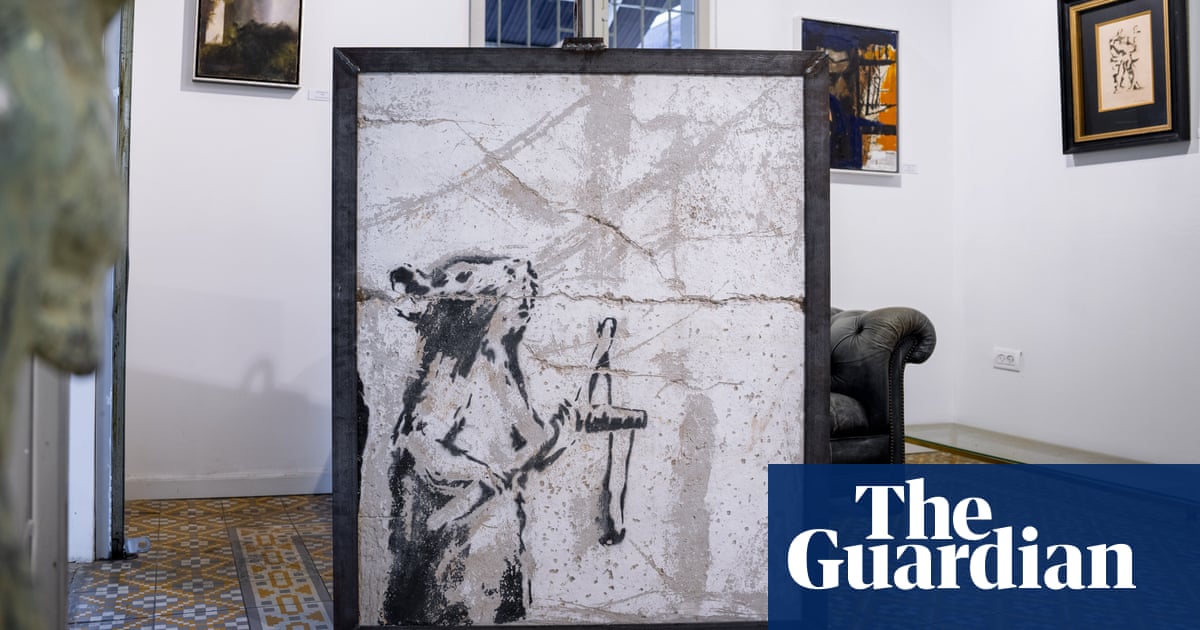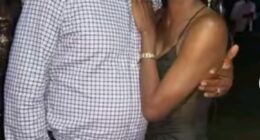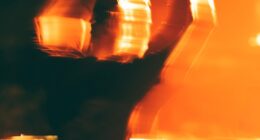The removal of Slingshot Rat has sparked debate over the legality of taking cultural artefacts from occupied land
A lost Banksy piece originally spray painted to protest against Israel’s separation barrier in the West Bank has resurfaced in a Tel Aviv gallery, sparking debate over the role of public art and the legality of removing cultural artefacts from occupied land.
Slingshot Rat, a stencil painting, appeared on a concrete block at an abandoned Israeli army position in Bethlehem next to a section of the wall in 2007, one of several works in the Palestinian town created in secret. Some time later, the painting was obscured and graffitied with the words, “RIP Banksy Rat”, and eventually cut out and removed by unknown persons.
Banksy, known for his absurdist and dystopian street art, has worked in the West Bank and Gaza Strip since 2005, and has auctioned paintings to raise funds for Palestinian causes.
Pieces of his work in Bethlehem have become a major element of the city’s tourism industry, with the Banksy-designed Walled Off hotel famously claiming to offer the “worst view of any hotel in the world” since it opened in 2017. Critics have accused the Bristol-born artist of trivialising the Israeli-Palestinian conflict.
According to Koby Abergel, the Israeli art dealer who purchased the painting, Slingshot Rat was in the possession of Palestinians who kept it in private residences until earlier this year.
A partner at the Urban gallery, where the work is now being displayed, Abergel said he bought the Banksy from an associate in Bethlehem, and had no plans to sell it. He declined to disclose the sum he paid or identify the seller, but insisted on the deal’s legality.
The art dealer said that the acrylic paint sprayed over the original work was carefully removed, and the 400kg (900lb) concrete slab was then enclosed in a steel frame so it could be lifted on to a flatbed truck and taken to its new location.
Slingshot Rat passed at least one military checkpoint to reach Tel Aviv. Both the Israeli military and Cogat, the Israeli defence ministry body responsible for civilian governance in the West Bank, said they had no knowledge of the artwork or its journey.
According to the 1954 Hague Convention governing cultural property to which Israel is a signatory, occupying powers must prevent the removal of cultural property from occupied territories.
“This is theft of the property of the Palestinian people,” said Jeries Qumsieh, a spokesperson for the Palestinian tourism ministry. “These were paintings by an international artist for Bethlehem, for Palestine, and for visitors to Bethlehem and Palestine. So transferring them, manipulating them and stealing them is definitely an illegal act.”
Israel started work on the contentious West Bank separation wall 20 years ago to stem Palestinian terror attacks during the second intifada, but construction stalled owing to a combination of internal politicking, legal battles and international criticism. The majority of the 65% of the barrier that has been built so far is inside the West Bank, rather than in Israel or on the armistice line.
To protect illegal Israeli settlements, some sections reach 22km (13 miles) into Palestinian territory, dividing communities and leaving farmers reliant on Israeli permits to access their own land.
In densely populated places such as Bethlehem, the barrier takes the form of an eight-metre-high concrete wall topped with barbed wire. In more rural areas, it is made up of parallel wire fences.
Banksy artworks have been removed from the West Bank twice before: Wet Dog and Stop and Search, both of which were created in Bethlehem, were eventually purchased by galleries in the US and UK and exhibited in 2011.
A spokesperson for Banksy did not respond to requests for comment on the reappearance of Slingshot Rat.
Lost Banksy piece sprayed in Palestine reappears in Tel Aviv gallery – The Guardian
“She Said I’d Be Dead or Jobless”: Jamaican-American TikTok Star Accused of Infecting Man with HIV and Using Political Power to Silence Him
By Peter Bird | Guest Investigative Writer Published: June 27, 2025 |…
- The Miami Post
- June 27, 2025
Zafir Rashid leads Nickelodeon resort launch in Orlando
The Nickelodeon Hotels & Resorts Orlando, expected to open in the first…
- The Miami Post
- April 14, 2025
The Day The Music Didn’T Stop: How Mastermindz Turned The Ground Into A 12+ Hour Rave
by Brenda Brooks I thought I’d seen it all. I’ve been shooting…
- The Miami Post
- April 2, 2025
Redefining Postpartum Care with Bayla at Home
Bayla is proud to be Florida’s first postpartum resort, offering an unparalleled…
- The Miami Post
- February 1, 2025








